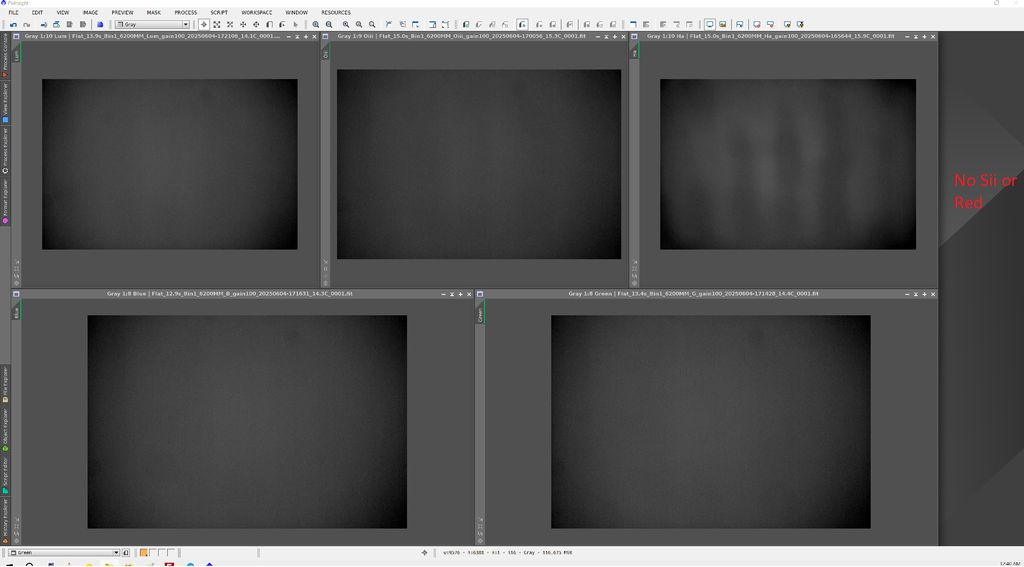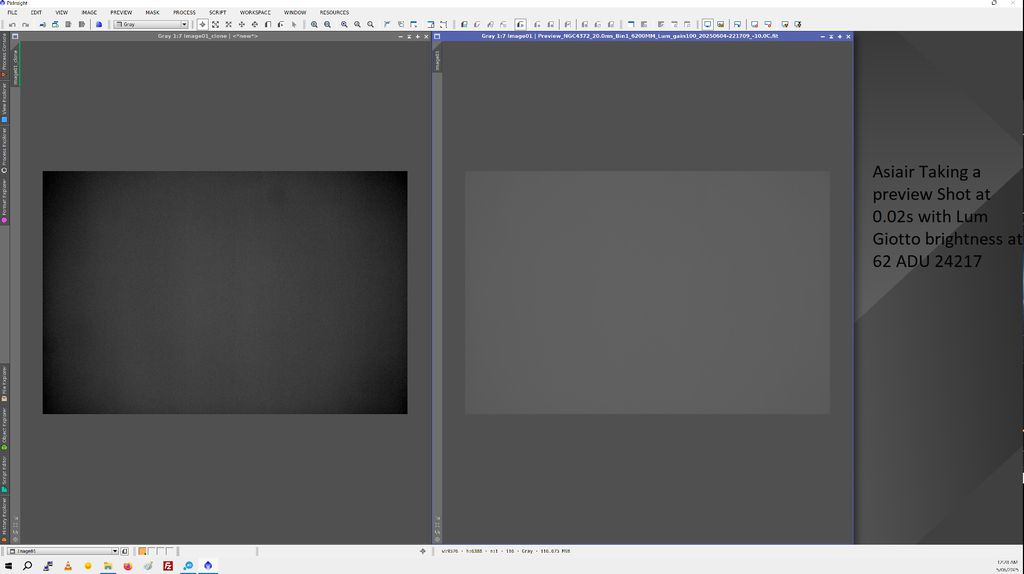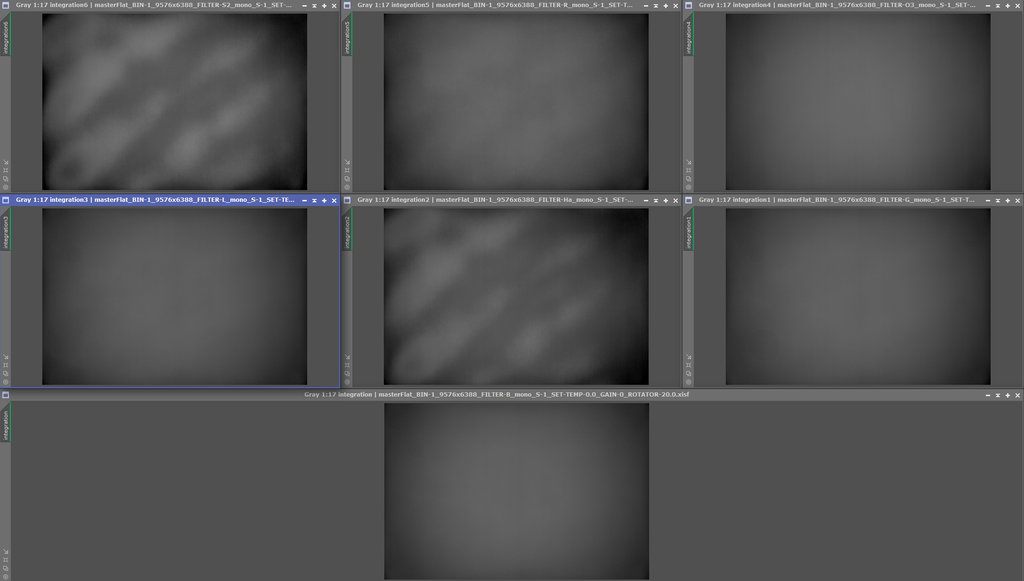I do think a lot of people haven't seen this "blobbiness" if their scope has any light drop-off from the center. The auto-stretching washes out any tiny unevenness. When I took flats with my Chroma NB filters and WO Cat91, I had similar concerns. These small variations weren't previously visible with flats from my Newt. But the Cat91 has great illumination to the edges compared to the Newt, so all the tiny variations suddenly showed up. I found the variations to be very small in the flat and didn't show up even on large stacks of calibrated underexposed NB images, where pattern noise would definitely show up.
|
You cannot like this item. Reason: "ANONYMOUS".
You cannot remove your like from this item.
Editing a post is only allowed within 24 hours after creating it.
You cannot Like this post because the topic is closed.
Copy the URL below to share a direct link to this post.
This post cannot be edited using the classic forums editor.
To edit this post, please enable the "New forums experience" in your settings.
You cannot like this item. Reason: "ANONYMOUS".
You cannot remove your like from this item.
Editing a post is only allowed within 24 hours after creating it.
You cannot Like this post because the topic is closed.
Copy the URL below to share a direct link to this post.
This post cannot be edited using the classic forums editor.
To edit this post, please enable the "New forums experience" in your settings.
I took some sky flats getting on dusk. Never done them before. Didint get a chance at Sii or red. I used the Asiars auto function and the ADU was 24 - 28000. 12-15 sec on the times. The pattern is dominant in Ha but can also be seen in the other filters. I also used my smaller power box to fire up the light panel just in case it was a power issue with my Bluetti. Rotated the flat panel and the rotator on the Askar. Image does not change direction as such. Interesting to see what the shop says on all my photos.  |
You cannot like this item. Reason: "ANONYMOUS".
You cannot remove your like from this item.
Editing a post is only allowed within 24 hours after creating it.
You cannot Like this post because the topic is closed.
Copy the URL below to share a direct link to this post.
This post cannot be edited using the classic forums editor.
To edit this post, please enable the "New forums experience" in your settings.
Using the Asiar Preview function with Lum. Thanks for the input fellas Ta  |
You cannot like this item. Reason: "ANONYMOUS".
You cannot remove your like from this item.
Editing a post is only allowed within 24 hours after creating it.
You cannot Like this post because the topic is closed.
Copy the URL below to share a direct link to this post.
This post cannot be edited using the classic forums editor.
To edit this post, please enable the "New forums experience" in your settings.
Have you tried a sky flat to rule out an interaction between the sensor and the panel? Do these flats calibrate properly?
|
You cannot like this item. Reason: "ANONYMOUS".
You cannot remove your like from this item.
Editing a post is only allowed within 24 hours after creating it.
You cannot Like this post because the topic is closed.
Copy the URL below to share a direct link to this post.
This post cannot be edited using the classic forums editor.
To edit this post, please enable the "New forums experience" in your settings.
Tony, I had a go at a skyflat above. I assume it was the right way. Just placed a white cloth over the objective. Used the Asiars flat auto function and the ADU was reasonable. Run out of light as I done them in the evening and skipped Sii and Red.
When you say do the flats calibrate properly; unsure here.
I have not had a chance to grab any subs for a photo as yet as the camera, filters and FW are new. So no actual finished photo to have a gander at. I did manage a 5 min sub on Carina with each filter.
Those fits are in the link (probably broken now)
Thanks for your input
|
You cannot like this item. Reason: "ANONYMOUS".
You cannot remove your like from this item.
Editing a post is only allowed within 24 hours after creating it.
You cannot Like this post because the topic is closed.
Copy the URL below to share a direct link to this post.
This post cannot be edited using the classic forums editor.
To edit this post, please enable the "New forums experience" in your settings.
Hi Stephen, I've just made the exact same jump as you - 2600mm with 36mm unmounted Antlia Filters to the 6200MM w/ 50mm round Antlia 3nm filters. I've mounted it to my Takahashi FSQ-106ED and I also have a Giotto Flat panel. I took my first sets of flats this morning, and noticed almost the exact same pattern in the autostretched image previews coming through NINA. I haven't had a chance to dig any further into it, but I'm going to jump into the rabbit hole after work tonight.
|
You cannot like this item. Reason: "ANONYMOUS".
You cannot remove your like from this item.
Editing a post is only allowed within 24 hours after creating it.
You cannot Like this post because the topic is closed.
Copy the URL below to share a direct link to this post.
This post cannot be edited using the classic forums editor.
To edit this post, please enable the "New forums experience" in your settings.
GDay Josh
I was going to send you a message as I follow you on AB and seen your photos in IIS as they give me ideas to something to chase through the trees in my back yard. I noticed you had that 6200 on an Askar 300 as well? So you have gremlins also..Real strange.
|
You cannot like this item. Reason: "ANONYMOUS".
You cannot remove your like from this item.
Editing a post is only allowed within 24 hours after creating it.
You cannot Like this post because the topic is closed.
Copy the URL below to share a direct link to this post.
This post cannot be edited using the classic forums editor.
To edit this post, please enable the "New forums experience" in your settings.
Did you use the flats in calibration & integration? Why not try and what happens. Also I’ll presume you’ll use bias frames in integration and if not you’ll use flat darks.
|
You cannot like this item. Reason: "ANONYMOUS".
You cannot remove your like from this item.
Editing a post is only allowed within 24 hours after creating it.
You cannot Like this post because the topic is closed.
Copy the URL below to share a direct link to this post.
This post cannot be edited using the classic forums editor.
To edit this post, please enable the "New forums experience" in your settings.
Stephen Jones:
GDay Josh
I was going to send you a message as I follow you on AB and seen your photos in IIS as they give me ideas to something to chase through the trees in my back yard. I noticed you had that 6200 on an Askar 300 as well? So you have gremlins also..Real strange. Hi Stephen, Thanks for the Follow! I primarily image with the Takahashi FSQ these days. Ive had the 2600MM mounted to it without issue for the last 2 years. I've only just received the 6200MM, and got it all setup over the weekend just gone. I'm only a few hours away from finishing work today and getting home at which point i'll be digging to my flats and seeing what i can see. If the weather's good enough i'll try to setup for some sky flats this evening to compare.
|
You cannot like this item. Reason: "ANONYMOUS".
You cannot remove your like from this item.
Editing a post is only allowed within 24 hours after creating it.
You cannot Like this post because the topic is closed.
Copy the URL below to share a direct link to this post.
This post cannot be edited using the classic forums editor.
To edit this post, please enable the "New forums experience" in your settings.
 This I what my full set of integrated flats looks like with the STF stretch turned on. I ran a few test calibrations on some Ha files and they seemed to calibrated out fine. I haven't had a chance to run a full stack to see if it will actually be an issue in reality. I've got a second set of flats at the different rotation angle that i haven't looked at yet. If the pattern stays the same, I can rule out the flat panel as a cause. At this point, if they calibrate my Lights properly, i'm not concerned, it's more of an intellectual exercise now.
|
You cannot like this item. Reason: "ANONYMOUS".
You cannot remove your like from this item.
Editing a post is only allowed within 24 hours after creating it.
You cannot Like this post because the topic is closed.
Copy the URL below to share a direct link to this post.
This post cannot be edited using the classic forums editor.
To edit this post, please enable the "New forums experience" in your settings.
Can you measure the total ADU count in a bright portion and again in a dark portion near the first measurement?
I was seeing up to 1000 ADU count difference out of a total of about 30,000
|
You cannot like this item. Reason: "ANONYMOUS".
You cannot remove your like from this item.
Editing a post is only allowed within 24 hours after creating it.
You cannot Like this post because the topic is closed.
Copy the URL below to share a direct link to this post.
This post cannot be edited using the classic forums editor.
To edit this post, please enable the "New forums experience" in your settings.
hi - this is totally normal with a back-side illuminated sensor and Ha and SII filters. the phenomenon is called "etaloning" and it is a consequence of the red light being exactly the right wavelength to bounce back and forth between the two surfaces of the photosensitive layer of silicon, and interfere with itself. see this article for the technical details: https://andor.oxinst.com/learning/view/article/optical-etaloning-in-charge-coupled-devices
rob |
You cannot like this item. Reason: "ANONYMOUS".
You cannot remove your like from this item.
Editing a post is only allowed within 24 hours after creating it.
You cannot Like this post because the topic is closed.
Copy the URL below to share a direct link to this post.
This post cannot be edited using the classic forums editor.
To edit this post, please enable the "New forums experience" in your settings.
oh and by the way i have a 6200MM as well and my Ha and SII flats look exactly like this.
|
You cannot like this item. Reason: "ANONYMOUS".
You cannot remove your like from this item.
Editing a post is only allowed within 24 hours after creating it.
You cannot Like this post because the topic is closed.
Copy the URL below to share a direct link to this post.
This post cannot be edited using the classic forums editor.
To edit this post, please enable the "New forums experience" in your settings.
hi - this is totally normal with a back-side illuminated sensor and Ha and SII filters. the phenomenon is called "etaloning" and it is a consequence of the red light being exactly the right wavelength to bounce back and forth between the two surfaces of the photosensitive layer of silicon, and interfere with itself.
see this article for the technical details:
https://andor.oxinst.com/learning/view/article/optical-etaloning-in-charge-coupled-devices
rob This is what my rudimentary research led me to believe is the cause. Optics is fun!
|
You cannot like this item. Reason: "ANONYMOUS".
You cannot remove your like from this item.
Editing a post is only allowed within 24 hours after creating it.
You cannot Like this post because the topic is closed.
Copy the URL below to share a direct link to this post.
This post cannot be edited using the classic forums editor.
To edit this post, please enable the "New forums experience" in your settings.
GDay fellas; appreciate your time.
I still dont understand why I did not see this whilst using the 2600mm if it is normal. Similar spec but larger sensor. I have not been doing this long but it goes against the grain. Some members here have some outstanding scopes and filters. My brain is like a light bulb reading the above. I get there is a lot of moving parts yet in a couple of these posts some members have not seen it. I get that optics etc can come into it.
Hope the subs calibrate when stacked and no corruption in a final image.
Curious if I move the Ha filter to the right to get the same pattern as above…Maybe I have the filters facing the wrong way. Feel like Sherlock Holmes
|
You cannot like this item. Reason: "ANONYMOUS".
You cannot remove your like from this item.
Editing a post is only allowed within 24 hours after creating it.
You cannot Like this post because the topic is closed.
Copy the URL below to share a direct link to this post.
This post cannot be edited using the classic forums editor.
To edit this post, please enable the "New forums experience" in your settings.
my 2600mm doesn’t do this either. it’s just all about how thick that active silicon layer is. it could be the 6200 sensor has to be a little thicker because it is much larger than the 2600. dunno.
your subs will calibrate fine, the pattern is there in the lights as well but is very subtle and is not noticeable under stretch suitable for the light subexposure.
|
You cannot like this item. Reason: "ANONYMOUS".
You cannot remove your like from this item.
Editing a post is only allowed within 24 hours after creating it.
You cannot Like this post because the topic is closed.
Copy the URL below to share a direct link to this post.
This post cannot be edited using the classic forums editor.
To edit this post, please enable the "New forums experience" in your settings.
GDay Fellas, just a follow up.
pfile, mate you are spot on.
I am a member on Adam Blocks Studio. At the time I did not think it was appropriate to post on his forum with an hardware issue as the site is geared for PI processing. But I asked Adam anyways. He responds very quickly. He is correct when he mentions that the red wave lengths like Red Ha and Sii will be affected more. Well worth being a member on Adam Block Studios….even if it was not PI processing. This is his reply:
1. Note.. you turned the camera/optics and yet the pattern remained fixed. What does this tell you? Answer: it is the camera.
2. The "fingers" are a dead giveaway of a cyclic/repeating pattern. What is interesting is your pattern is actually what you would WANT to see in a text book example.
3. You did not say this- but I am going to guess you do not see the pattern strongly in Blue, Green, or OIII … but in Red, Ha, and SII. So all of this points to the very common effect of interference. At some wavelength the coating on the window of your sensor (or the sensor itself) has a particular thickness to cause an interference pattern. That is what you are seeing. This is physics! The typical coating thickness correspond to redder wavelengths of light. Fast telescopes in particular can help the interference pattern show up.
The good news is that this pattern will be the same for any images (lights and flats). So it calibrates out.
With my 61mm RedCat and Ha or SII…the flats are a bizarre squiggle mess of blotches. Your example means your coating was very evenly applied and is a similar thickness throughout. The real test as you indicate is to calibrate your data with those flats. As long as you do everything properly… it should work out just fine.
Another name for the effect is "fringing" and professional astronomers deal with this all the time because they use thinned back-illuminated sensors. -the Blockhead
|
You cannot like this item. Reason: "ANONYMOUS".
You cannot remove your like from this item.
Editing a post is only allowed within 24 hours after creating it.
You cannot Like this post because the topic is closed.
Copy the URL below to share a direct link to this post.
This post cannot be edited using the classic forums editor.
To edit this post, please enable the "New forums experience" in your settings.





